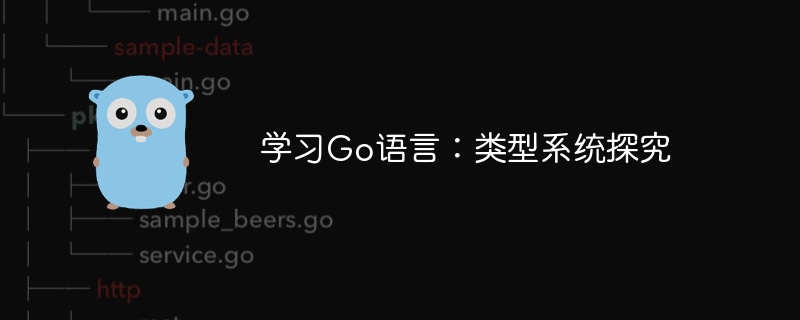

Title: Learning Go language: Exploration of type system
Go language is an open source programming language developed by Google. It is widely used for its simplicity, efficiency, concurrency and other characteristics. Loved by programmers. The Go language has a static type system, which makes the code more secure and maintainable. This article will explore the type system of the Go language and provide specific code examples for readers to have an in-depth understanding of the types of the Go language.
First, let us understand the basic data types in Go language. In the Go language, basic data types include integers, floating point types, Boolean types, strings, etc. The following are definitions and sample codes of some basic types:
// 整型 var num1 int = 10 var num2 int = 20 // 浮点型 var num3 float64 = 3.14 var num4 float64 = 6.28 // 布尔型 var isTrue bool = true var isFalse bool = false // 字符串 var str1 string = "Hello" var str2 string = "World"
In addition to basic data types, the Go language also supports custom types. Through the type keyword, we can define a new type, which can be an alias of a basic type or a structure. The following is a sample code for a custom type:
// 自定义类型
type myInt int
type person struct {
name string
age int
}
// 使用自定义类型
var num myInt = 100
var p person = person{name: "Alice", age: 30}In the Go language, type conversion is a common operation. Type conversion can convert between different types, but you need to pay attention to the compatibility between types. The following is a sample code for type conversion:
var x int = 10 var y float64 = float64(x) fmt.Println(y) // 输出:10.0
In addition, the Go language also supports interface types. An interface defines a set of methods. As long as a type implements all methods defined in the interface, it is said to implement the interface. The following is a sample code for an interface type:
// 定义接口
type Sayer interface {
Say()
}
// 定义结构体
type Dog struct {}
// 实现接口
func (d Dog) Say() {
fmt.Println("汪汪汪")
}Finally, the Go language also supports empty interface types. The empty interface type can represent any type of value, so it is widely used in the Go language. The following is a sample code for an empty interface type:
// 定义空接口
var x interface{}
// 赋值任意类型的值
x = 10
fmt.Println(x) // 输出:10
x = "Hello"
fmt.Println(x) // 输出:HelloThrough the above code examples, we can have a deeper understanding of the type system of the Go language. Type is an important part of a program. Reasonable type design can improve the readability and robustness of the code. I hope that through the introduction of this article, readers will have a deeper understanding of the type system of the Go language, and be able to flexibly use the concept of types in actual projects to write efficient and maintainable code.
The above is the detailed content of Learning the Go language: An exploration of the type system. For more information, please follow other related articles on the PHP Chinese website!
 Usage of Type keyword in Go
Usage of Type keyword in Go
 How to implement linked list in go
How to implement linked list in go
 What are the Go language programming software?
What are the Go language programming software?
 How to learn go language from 0 basics
How to learn go language from 0 basics
 What are the methods to implement operator overloading in Go language?
What are the methods to implement operator overloading in Go language?
 What are the operators in Go language?
What are the operators in Go language?
 Top 10 most secure digital currency exchanges in 2024
Top 10 most secure digital currency exchanges in 2024
 How to register on Binance
How to register on Binance




